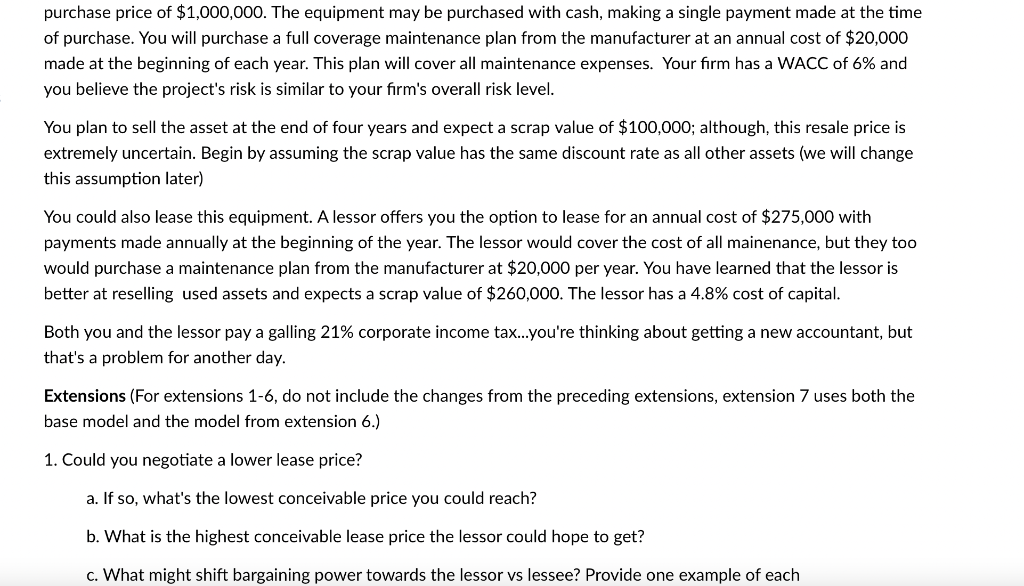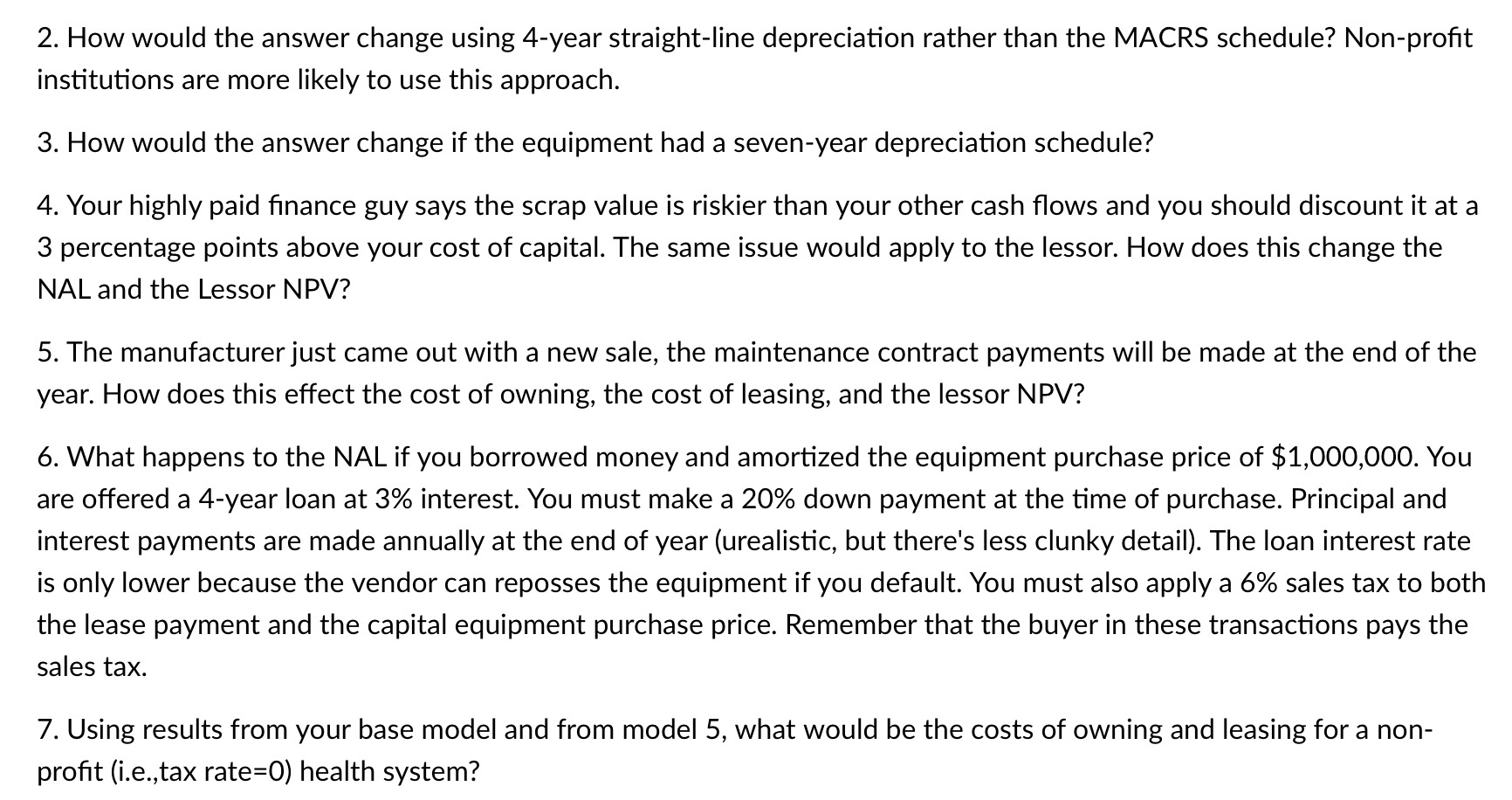


. Acquiring equipment with a purchase price of $1,000,000. The equipment may be purchased with cash, making a single payment made at the time of purchase. You will purchase a full coverage maintenance plan from the manufacturer at an annual cost of $20,000 made at the beginning of each year. This plan will cover all maintenance expenses. Your firm has a WACC of 6% and you believe the project's risk is similar to your firm's overall risk level. You plan to sell the asset at the end of four years and expect a scrap value of $100,000; although, this resale price is extremely uncertain. Begin by assuming the scrap value has the same discount rate as all other assets (we will change this assumption later) You could also lease this equipment. A lessor offers you the option to lease for an annual cost of $275,000 with payments made annually at the beginning of the year. The lessor would cover the cost of all mainenance, but they too would purchase a maintenance plan from the manufacturer at $20,000 per year. You have learned that the lessor is better at reselling used assets and expects a scrap value of $260,000. The lessor has a 4.8% cost of capital. Both you and the lessor pay a galling 21% corporate income tax...you're thinking about getting a new accountant, but that's a problem for another day. Extensions (For extensions 1-6, do not include the changes from the preceding extensions, extension 7 uses both the base model and the model from extension 6.) 1. Could you negotiate a lower lease price? a. If so, what's the lowest conceivable price you could reach? b. What is the highest conceivable lease price the lessor could hope to get? c. What might shift bargaining power towards the lessor vs lessee? Provide one example of each 2. How would the answer change using 4-year straight-line depreciation rather than the MACRS schedule? Non-profit institutions are more likely to use this approach. 3. How would the answer change if the equipment had a seven-year depreciation schedule? 4. Your highly paid finance guy says the scrap value is riskier than your other cash flows and you should discount it at a 3 percentage points above your cost of capital. The same issue would apply to the lessor. How does this change the NAL and the Lessor NPV? 5. The manufacturer just came out with a new sale, the maintenance contract payments will be made at the end of the year. How does this effect the cost of owning, the cost of leasing, and the lessor NPV? 6. What happens to the NAL if you borrowed money and amortized the equipment purchase price of $1,000,000. You are offered a 4-year loan at 3% interest. You must make a 20% down payment at the time of purchase. Principal and interest payments are made annually at the end of year (urealistic, but there's less clunky detail). The loan interest rate is only lower because the vendor can reposses the equipment if you default. You must also apply a 6% sales tax to both the lease payment and the capital equipment purchase price. Remember that the buyer in these transactions pays the sales tax. 7. Using results from your base model and from model 5, what would be the costs of owning and leasing for a non- profit (i.e.,tax rate=0) health system? . Acquiring equipment with a purchase price of $1,000,000. The equipment may be purchased with cash, making a single payment made at the time of purchase. You will purchase a full coverage maintenance plan from the manufacturer at an annual cost of $20,000 made at the beginning of each year. This plan will cover all maintenance expenses. Your firm has a WACC of 6% and you believe the project's risk is similar to your firm's overall risk level. You plan to sell the asset at the end of four years and expect a scrap value of $100,000; although, this resale price is extremely uncertain. Begin by assuming the scrap value has the same discount rate as all other assets (we will change this assumption later) You could also lease this equipment. A lessor offers you the option to lease for an annual cost of $275,000 with payments made annually at the beginning of the year. The lessor would cover the cost of all mainenance, but they too would purchase a maintenance plan from the manufacturer at $20,000 per year. You have learned that the lessor is better at reselling used assets and expects a scrap value of $260,000. The lessor has a 4.8% cost of capital. Both you and the lessor pay a galling 21% corporate income tax...you're thinking about getting a new accountant, but that's a problem for another day. Extensions (For extensions 1-6, do not include the changes from the preceding extensions, extension 7 uses both the base model and the model from extension 6.) 1. Could you negotiate a lower lease price? a. If so, what's the lowest conceivable price you could reach? b. What is the highest conceivable lease price the lessor could hope to get? c. What might shift bargaining power towards the lessor vs lessee? Provide one example of each 2. How would the answer change using 4-year straight-line depreciation rather than the MACRS schedule? Non-profit institutions are more likely to use this approach. 3. How would the answer change if the equipment had a seven-year depreciation schedule? 4. Your highly paid finance guy says the scrap value is riskier than your other cash flows and you should discount it at a 3 percentage points above your cost of capital. The same issue would apply to the lessor. How does this change the NAL and the Lessor NPV? 5. The manufacturer just came out with a new sale, the maintenance contract payments will be made at the end of the year. How does this effect the cost of owning, the cost of leasing, and the lessor NPV? 6. What happens to the NAL if you borrowed money and amortized the equipment purchase price of $1,000,000. You are offered a 4-year loan at 3% interest. You must make a 20% down payment at the time of purchase. Principal and interest payments are made annually at the end of year (urealistic, but there's less clunky detail). The loan interest rate is only lower because the vendor can reposses the equipment if you default. You must also apply a 6% sales tax to both the lease payment and the capital equipment purchase price. Remember that the buyer in these transactions pays the sales tax. 7. Using results from your base model and from model 5, what would be the costs of owning and leasing for a non- profit (i.e.,tax rate=0) health system









